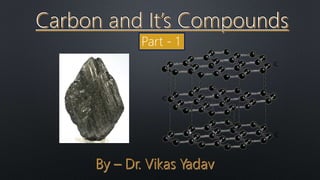
Carbon bonding types
- 1. Part - 1
- 2. SAWASDEE
- 3. R u ready for class?? Rotate your head slowly-slowly in clockwise and anticlockwise directions. Find your seat Bell Ringer As you come in and get settled, follow these instructions:
- 4. WARM UP QUESTIONS Q1 – What is atomic number of carbon??
- 5. Q2 – Write the electronic configuration of carbon.
- 6. Dramatic Presentation Different forms of Carbon
- 7. In this topic you will learn about the special behaviour of carbon i.e. why does carbon form a large number of compounds? Why does it link together to form a long chain compound? Why it has a special property among all other elements present in periodic table?
- 8. Core Skills Carbon always forms covalent compounds by sharing its electrons with other atoms. Now, in covalent bonding, the two electrons shared by the atoms are attracted to the nucleus of both atoms and neither atom completely loses or gains electrons as in ionic bonding. So the compounds in which all the atoms are directly attached to C-atom, contain covalent bonding and no ionic bond.
- 9. The atomic number of carbon is 6. Its electronic configuration is 2, 4. So, it requires 4 electrons to achieve the inert gas electronic configuration. But carbon cannot form an ionic bond. It could gain four electrons forming C4- cation. But it would be difficult for the nucleus with six protons to hold on to ten electrons. It could lose four electrons forming C4+ cations. But it requires a large amount of energy to remove four electrons.
- 11. Thus, carbon overcomes this problem by sharing of its valence electrons with other carbon atoms or with atoms of other elements. Thus, the bond formed by mutual sharing of electron pairs between two atoms in a molecule is known as Covalent Bond. Types of Covalent Bond: Single Covalent Bond: When a single pair of electrons are shared between two atoms in a molecule. For example - F2, Cl2, H2 etc.
- 12. Double Covalent Bond: When two pairs of electrons are shared between two atoms in a molecule. For example - O2, CO2 etc. Triple Covalent Bond - When three pairs of electrons are shared between two atoms in a molecule. For example; N2 etc. WORK SPACE
- 13. Electron Dot Structure: The electron dot structures provide a picture of bonding in molecules in terms of the shared pairs of electrons and octet rule. Formation of Hydrogen Molecule Atomic number of Hydrogen = 1 Number of valence electrons = 1
- 14. Formation of CH4 Molecule Atomic number of Carbon = 6 [2, 4] Number of valence electrons = 4 Atomic number of Hydrogen = 1 Number of valence electrons = 1
- 15. Formation of CO2 Molecule Atomic number of Carbon = 6 [2, 4] Number of valence electrons = 4 Atomic number of Oxygen = 8 [2, 6] Number of valence electrons = 6
- 16. Formation of H2S Molecule Atomic number of Sulphur = 16 [2, 8, 6] Number of valence electrons = 6
- 17. Physical Properties of Organic Compounds Covalent compounds can exist in all three states of matter i.e. gaseous, liquids and solid state. Most of the covalent organic compounds have low boiling and melting point, due to the weak force of attraction (i.e., the inter-molecular force of attraction) among their molecules. Most covalent carbon compounds are poor conductors of electricity, due to the absence of free electrons and free ions.
- 18. QUIZ TIME
- 19. Fill the correct answer – Carbon can form only ______________ type of bonds
- 20. Mark the correct answer – The property of self-linkage among identical atoms to form long chain compounds is known as: a) Catenation b) Isomerisation c) Superposition d) Halogenation
- 21. HOW WELL DID YOU LIKE THIS TOPIC?
- 22. ASSIGNMENT Q1 – Write the electronic configuration of Carbon. Q2 – How many number of valence electrons present on the carbon atom?